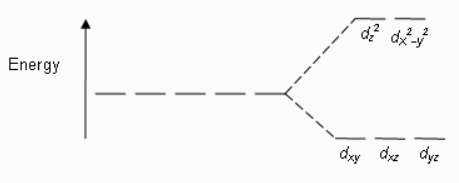
The d-orbitals involved in
(this question has multiple correct options)
a.)
b.)
c.)
d.)
Answer
510.3k+ views
Hint: From the given hybridization we can say that the geometry of the compound has octahedral. So, to solve this question, consider the splitting of d-orbitals in an octahedral complex, when approached by a ligand.
Complete step by step solution:
When any negatively charged species or ligand approaches a metal, the energy of the orbitals increases. This leads to the splitting of orbitals as –

In octahedral complexes, the splitting of orbitals always takes place in this manner.
The electron first goes to the lower energy orbital, i.e.
In case of
In case of
Therefore, the answer is – option (a) and option (d).
Additional information: In short, if inner d-orbital is used for bonding, the hybridization will be
Note: Irrespective of the differences between
Both hybridization results in octahedral geometry.
Both have six hybrid orbitals.
There is an angle of 90 degrees between hybrid orbitals.
Complete step by step solution:
When any negatively charged species or ligand approaches a metal, the energy of the orbitals increases. This leads to the splitting of orbitals as –

In octahedral complexes, the splitting of orbitals always takes place in this manner.
The electron first goes to the lower energy orbital, i.e.
In case of
In case of
Therefore, the answer is – option (a) and option (d).
Additional information: In short, if inner d-orbital is used for bonding, the hybridization will be
Note: Irrespective of the differences between
Both hybridization results in octahedral geometry.
Both have six hybrid orbitals.
There is an angle of 90 degrees between hybrid orbitals.
Recently Updated Pages
Master Class 11 Economics: Engaging Questions & Answers for Success

Master Class 11 Business Studies: Engaging Questions & Answers for Success

Master Class 11 Accountancy: Engaging Questions & Answers for Success

Master Class 11 English: Engaging Questions & Answers for Success

Master Class 11 Computer Science: Engaging Questions & Answers for Success

Master Class 11 Maths: Engaging Questions & Answers for Success

Trending doubts
Which one is a true fish A Jellyfish B Starfish C Dogfish class 11 biology CBSE

State and prove Bernoullis theorem class 11 physics CBSE

1 ton equals to A 100 kg B 1000 kg C 10 kg D 10000 class 11 physics CBSE

In which part of the body the blood is purified oxygenation class 11 biology CBSE

One Metric ton is equal to kg A 10000 B 1000 C 100 class 11 physics CBSE

Difference Between Prokaryotic Cells and Eukaryotic Cells




